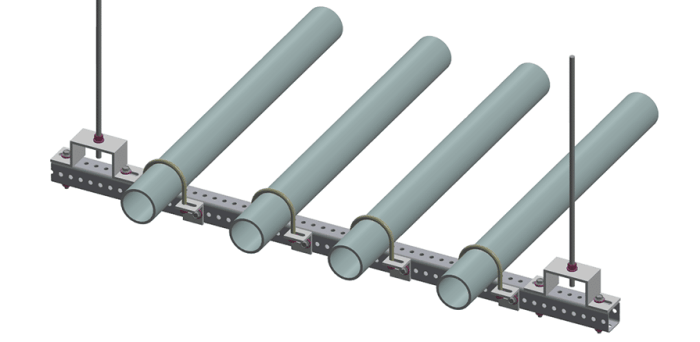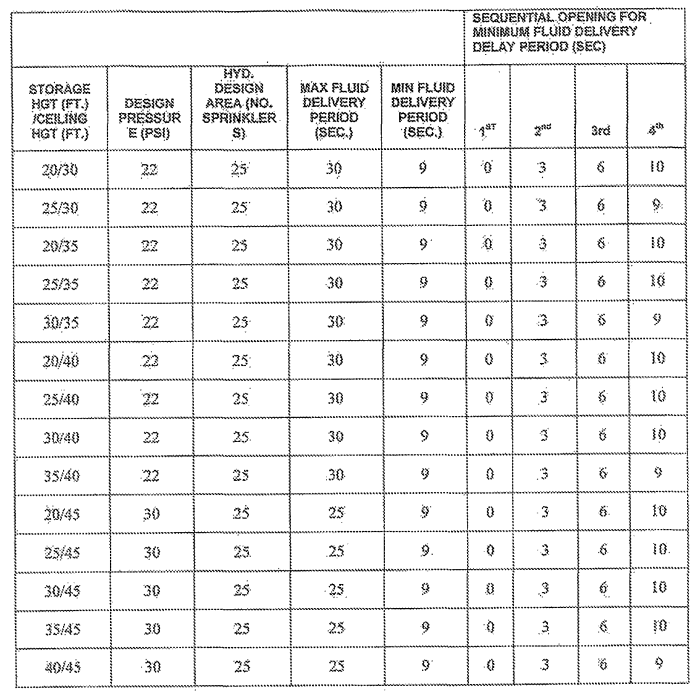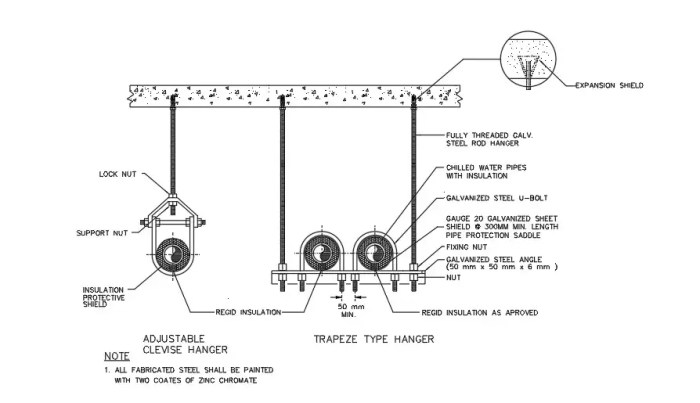Welcome to the comprehensive guide to the NFPA 13 Trapeze Hanger Chart, an indispensable resource for ensuring the safety and integrity of fire protection systems. This chart provides detailed specifications and guidelines for the proper installation and maintenance of trapeze hangers, crucial components in supporting sprinkler systems and other fire suppression equipment.
Throughout this guide, we will explore the significance of the NFPA 13 Trapeze Hanger Chart, its components, applications, limitations, and industry best practices. Join us as we delve into the world of fire protection and discover how this chart empowers professionals to design, install, and maintain effective fire suppression systems.
Overview of NFPA 13 Trapeze Hanger Chart

The NFPA 13 Trapeze Hanger Chart is a comprehensive resource that provides guidelines for the safe installation and use of trapeze hangers in sprinkler systems. It is an essential tool for engineers, contractors, and inspectors involved in the design, installation, and maintenance of fire sprinkler systems.
The chart was first developed in the early 1900s and has undergone several revisions over the years to keep pace with advances in sprinkler technology. The current version of the chart, NFPA 13: Standard for the Installation of Sprinkler Systems, 2022 Edition, includes the latest requirements for trapeze hangers, including specifications for materials, dimensions, and installation methods.
Purpose and Significance
The NFPA 13 Trapeze Hanger Chart serves several important purposes:
- Ensures the safe and reliable performance of sprinkler systems by providing guidelines for the proper installation and use of trapeze hangers.
- Promotes consistency in the design and installation of sprinkler systems, reducing the risk of errors and ensuring that systems meet code requirements.
- Facilitates communication between engineers, contractors, and inspectors by providing a common language and set of standards for trapeze hanger installations.
Components of the NFPA 13 Trapeze Hanger Chart

The NFPA 13 Trapeze Hanger Chart provides detailed specifications and guidelines for the installation and use of trapeze hangers in fire sprinkler systems. The chart includes several key elements and sections that help ensure the proper design, installation, and maintenance of these critical components.
One of the most important sections of the chart is the table of trapeze hanger specifications. This table lists the different types of trapeze hangers available, their corresponding load capacities, and the materials from which they are constructed. The chart also includes information on the proper spacing and installation of trapeze hangers, as well as the minimum clearances that must be maintained around them.
In addition to the table of specifications, the NFPA 13 Trapeze Hanger Chart also includes several other sections that provide important information on the use and maintenance of trapeze hangers. These sections include:
- A section on the proper installation of trapeze hangers, including step-by-step instructions and illustrations.
- A section on the proper maintenance of trapeze hangers, including tips on how to inspect and clean them.
- A section on the potential hazards associated with the improper use of trapeze hangers.
The NFPA 13 Trapeze Hanger Chart is an essential resource for anyone involved in the design, installation, or maintenance of fire sprinkler systems. By following the guidelines provided in the chart, you can help ensure that your fire sprinkler system is properly installed and maintained, and that it will be able to perform its intended function in the event of a fire.
Applications of the NFPA 13 Trapeze Hanger Chart

The NFPA 13 Trapeze Hanger Chart finds widespread application in various industries and sectors, particularly where fire protection systems are crucial for safeguarding lives and property.
Trapeze hangers play a vital role in suspending piping systems, including sprinkler pipes, within fire protection systems. They provide support and stability, ensuring the proper functioning of these systems during a fire event.
The NFPA 13 Trapeze Hanger Chart is a crucial resource for ensuring the safety and reliability of fire sprinkler systems. Just as a runner needs a well-planned training regimen to conquer a 10km race as outlined here , proper installation and maintenance of trapeze hangers is essential for the effective operation of fire sprinklers.
The chart provides detailed specifications and guidelines to help ensure that these hangers meet the necessary standards, safeguarding both property and lives.
Industries and Sectors
- Commercial Buildings: Offices, shopping malls, hotels, and other commercial establishments rely on fire protection systems to protect their occupants and assets.
- Industrial Facilities: Factories, warehouses, and manufacturing plants often have extensive piping systems that require proper support and suspension.
- Institutional Buildings: Hospitals, schools, and government buildings prioritize fire safety, making the use of trapeze hangers essential for their fire protection systems.
- Residential Buildings: High-rise apartments, condominiums, and townhouses incorporate fire protection systems to protect residents and their belongings.
Specific Applications
- Sprinkler Systems: Trapeze hangers are used to suspend sprinkler pipes, ensuring the proper distribution of water during a fire.
- Standpipes: In high-rise buildings, trapeze hangers support standpipes, which provide firefighters with access to water for firefighting operations.
- Fire Alarm Systems: Trapeze hangers can support fire alarm piping, ensuring the timely detection and notification of a fire.
- HVAC Systems: In some cases, trapeze hangers are used to support HVAC piping, which helps maintain proper air circulation and temperature control.
Real-World Examples
- In a recent high-rise apartment fire, the NFPA 13 Trapeze Hanger Chart was used to design and install the sprinkler system. The trapeze hangers provided adequate support for the sprinkler pipes, ensuring the effective distribution of water to extinguish the fire.
- A large industrial facility used the chart to determine the appropriate trapeze hangers for suspending its extensive piping system. The hangers ensured the stability of the piping, preventing any potential failures that could have led to a fire or other safety hazards.
- A hospital’s fire protection system was upgraded using the NFPA 13 Trapeze Hanger Chart. The trapeze hangers were used to support the sprinkler pipes and standpipes, providing reliable fire protection for patients and staff.
Limitations and Considerations of the NFPA 13 Trapeze Hanger Chart

While the NFPA 13 Trapeze Hanger Chart provides valuable guidance, it has certain limitations and considerations that users should be aware of when selecting and installing trapeze hangers.
Factors to Consider
- Load capacity:The chart only provides general load capacities for specific trapeze hanger types. Actual load capacity may vary depending on factors such as the specific design, materials used, and installation conditions.
- Environmental conditions:The chart does not account for environmental factors such as temperature, humidity, and corrosive atmospheres, which can affect the performance of trapeze hangers.
- Installation requirements:The chart does not provide detailed installation instructions or specifications. Users should refer to the manufacturer’s guidelines and applicable codes for proper installation.
Alternatives and Supplemental Resources
In cases where the NFPA 13 Trapeze Hanger Chart does not provide sufficient guidance, users may consider the following alternatives or supplemental resources:
- Manufacturer’s specifications:Trapeze hanger manufacturers provide detailed specifications and installation instructions for their products, which should be consulted for specific applications.
- Engineering analysis:For complex or high-load applications, it may be necessary to perform an engineering analysis to determine the appropriate trapeze hanger design and installation requirements.
- Other industry standards:There are other industry standards, such as ANSI/ASHRAE 170, that provide guidance on the design and installation of trapeze hangers.
Industry Best Practices for Using the NFPA 13 Trapeze Hanger Chart

To effectively utilize the NFPA 13 Trapeze Hanger Chart, industry best practices and standards must be followed. These guidelines ensure optimal design and installation of sprinkler systems, promoting safety and reliability.
One crucial aspect is adherence to the National Fire Protection Association (NFPA) 13 standard. This comprehensive document provides detailed requirements for the installation of sprinkler systems, including the use of trapeze hangers. By following these guidelines, engineers and contractors can ensure that sprinkler systems meet the necessary safety and performance criteria.
Importance of Following Industry Standards and Guidelines
- Enhanced Safety:Following industry standards ensures that sprinkler systems are designed and installed to meet stringent safety requirements, protecting lives and property.
- Improved Performance:Adhering to guidelines helps optimize the performance of sprinkler systems, ensuring they function effectively in the event of a fire.
- Compliance with Regulations:Following industry standards helps meet regulatory requirements and avoid potential legal liabilities.
Tips for Optimizing Design and Installation Process, Nfpa 13 trapeze hanger chart
To optimize the design and installation process using the NFPA 13 Trapeze Hanger Chart, consider the following tips:
- Accurate Load Calculations:Determine the exact load requirements for the sprinkler system to select the appropriate trapeze hanger size.
- Proper Spacing and Alignment:Ensure that trapeze hangers are spaced and aligned correctly to provide adequate support for the sprinkler piping.
- Secure Attachment:Trapeze hangers should be securely attached to the supporting structure using appropriate fasteners.
- Corrosion Resistance:Select trapeze hangers made of corrosion-resistant materials to withstand harsh environmental conditions.
Common Queries
What is the purpose of the NFPA 13 Trapeze Hanger Chart?
The NFPA 13 Trapeze Hanger Chart provides detailed specifications and guidelines for the proper installation and maintenance of trapeze hangers used in fire protection systems.
What are the key elements included in the NFPA 13 Trapeze Hanger Chart?
The chart includes information on the types of trapeze hangers, their corresponding specifications, installation requirements, and maintenance guidelines.
Where is the NFPA 13 Trapeze Hanger Chart commonly used?
The chart is widely used in the design, installation, and maintenance of fire protection systems in various industries, including commercial buildings, industrial facilities, and residential complexes.